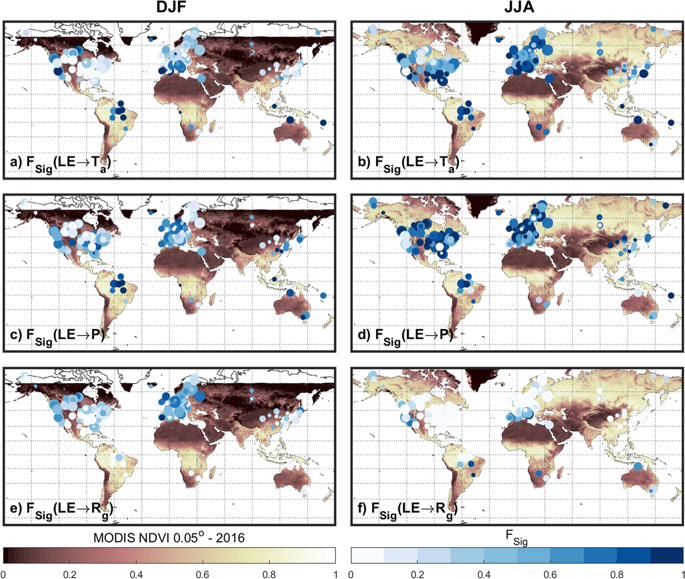npj Climate and Atmospheric Science ( IF 8.5 ) Pub Date : 2019-10-15 , DOI: 10.1038/s41612-019-0094-4 Tobias Gerken , Benjamin L. Ruddell , Rong Yu , Paul C. Stoy , Darren T. Drewry

|
Feedbacks between atmospheric processes like precipitation and land surface fluxes including evapotranspiration are difficult to observe, but critical for understanding the role of the land surface in the Earth System. To quantify global surface-atmosphere feedbacks we use results of a process network (PN) applied to 251 eddy covariance sites from the LaThuile database to train a neural network across the global terrestrial surface. There is a strong land–atmosphere coupling between latent (LE) and sensible heat flux (H) and precipitation (P) during summer months in temperate regions, and between H and P during winter, whereas tropical rainforests show little coupling seasonality. Savanna, shrubland, and other semi-arid ecosystems exhibit strong responses in their coupling behavior based on water availability. Feedback couplings from surface fluxes to P peaks at aridity (P/potential evapotranspiration ETp) values near unity, whereas coupling with respect to clouds, inferred from reduced global radiation, increases as P/ETp approaches zero. Spatial patterns in feedback coupling strength are related to climatic zone and biome type. Information flow statistics highlight hotspots of (1) persistent land–atmosphere coupling in sub-Saharan Africa, (2) boreal summer coupling in the central and southwestern US, Brazil, and the Congo basin and (3) in the southern Andes, South Africa and Australia during austral summer. Our data-driven approach to quantifying land atmosphere coupling strength that leverages the global FLUXNET database and information flow statistics provides a basis for verification of feedback interactions in general circulation models and for predicting locations where land cover change will feedback to climate or weather.
中文翻译:

利用FLUXNET的信息流对陆地到大气的反馈进行稳健的观测
很难观察到大气过程(如降水)与包括蒸发蒸腾在内的地表通量之间的反馈,但对于理解地表在地球系统中的作用至关重要。为了量化全球地面-大气反馈,我们使用过程网络(PN)的结果,该过程网络应用于LaThuile数据库中的251个涡度协方差站点,以训练遍布全球地面的神经网络。有潜(LE)和显热通量(之间有很强的陆气耦合ħ)和沉淀(P期间在温带地区夏季)之间,以及ħ和P在冬季,热带雨林几乎没有耦合的季节性。稀树草原,灌木丛和其他半干旱生态系统在基于水可利用量的耦合行为中表现出强烈的反应。从表面通量到干旱处的P峰值(P /潜在蒸散量ET p)的反馈耦合值接近于1,而从整体辐射减少推断的与云的耦合则随着P / ET p的增加而增加。接近零。反馈耦合强度的空间格局与气候带和生物群落类型有关。信息流统计数据突出显示了以下热点:(1)撒哈拉以南非洲持续的土地-大气耦合;(2)美国中部和西南部,巴西,刚果盆地的北半球夏季耦合;以及(3)南非安第斯山脉南部和澳大利亚在南方的夏季。我们的数据驱动方法利用全球FLUXNET数据库和信息流统计数据来量化土地-大气耦合强度,为验证常规环流模型中的反馈相互作用以及预测土地覆盖变化将反馈给气候或天气的位置提供了基础。











































 京公网安备 11010802027423号
京公网安备 11010802027423号